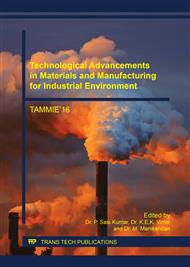p.34
p.41
p.48
p.58
p.64
p.73
p.81
p.88
p.97
Effects of Nano Particles on the Microstructure of LM 25 (A356) Alloy Manufactured by Squeeze Casting
Abstract:
Conventional casting process cannot produce parts as strong as forged parts. Also there are chances of many casting defects such as porosity, hot tears, shrinkage, pin holes, blow holes, mould shift flash, slag, short casting, when casting method is used for fabrication. Thus cast parts only have low mechanical properties. Recent trend is to use Squeeze Casting, which results in superior mechanical and casting properties. This technique is a hybrid metal forming process combining features of both casting and forging in one operation. This process is suitable for low melting alloys like iron and nickel with mechanical properties enhancement. Reduction in micro porosity in cast part and also reduction in machining. Historically, the series of LM were developed for high strength, corrosion resistance, and good machinability for many applications. In this study Squeeze Casting process has been used, since it has porosity free equiaxed grain components of LM 25 composition and cylindrical shaped castings were manufactured successfully by squeeze casting machine at high temperature and high pressure. The first part of the study is about the microstructure of the LM 25 Al-7 Si-0.3 Mg-0.5 Fe alloy. The casting products were made by addition of nano particles and without nano particles. The size of bar casted was by squeeze casting process. It was 260 mm*46mm (7 Pieces). Microstructure of Cast without squeeze and without stirrer, without squeeze and with stirrer, with squeeze and with stirrer Alloys was studied. The second part of the work was the heat treatment process of the finished product. Heat treatment process was conducted at 490○C and for the heat treated metals was quenched at 30○C (water) for the heat treated and unheated metal casting product were taken and microstructure were studied. The results were compared before and after the heat treatment process for addition of nano particles and without nano particles.
Info:
Periodical:
Pages:
64-70
Citation:
Online since:
July 2017
Authors:
Keywords:
Price:
Сopyright:
© 2017 Trans Tech Publications Ltd. All Rights Reserved
Share:
Citation:


